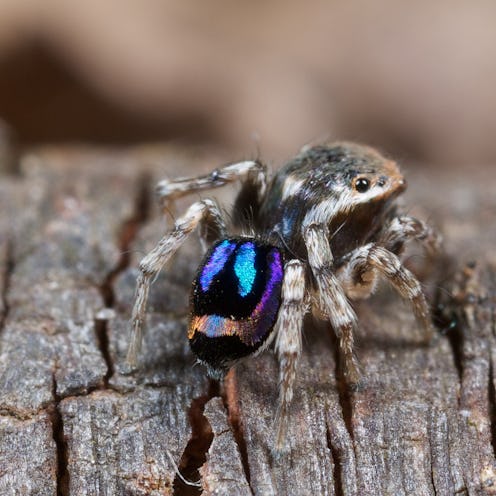Life
These Tiny Rainbow Spiders Could Hold The Key To A Wave Of New Technology

Even if you're not particularly fond of spiders, you've got admit that tiny Australian rainbow peacock spiders are kinda cute. They're one of the most colorful iridescent animals on the planet, while also being incredibly small: males only grow up to 5mm, or 0.2 inches. The males are the ones who've also become the target of scientific inquiry: they've got the rainbow coloring that gives the species its name, using it to attract females in spectacular displays. And now investigations into how they get that rainbow glow might help future technologies for humans, from biotechnology to microscopes.
Iridiescent animals and insects are often famous and highly prized; peacock feathers themselves are examples of iridescence, as are many butterfly wings. Beetles, birds and a kind of gecko all show off the look, too. There's even an iridescent mammal: a shimmering golden mole, which is sadly blind and can't see its own prettiness. Iridescence itself is a pretty peculiar natural phenomenon, and occurs because of the fact that light travels in wavelengths. The structure of an iridescent surface means that light waves combine with one another, lining up their wavelengths and strengthening the color that's produced. Depending on your point of view when looking at an iridescent object, you're either seeing light waves line up (something called constructive interference, which strengthens color) or waves fall out of sync (which is called destructive interference and means colors dim). This is why iridescent creatures like the rainbow spider shimmer and shift in color as they move.
Figuring out how such a small creature can pack such a color-punch, though, has remained a bit of a mystery until now. An international team of researchers decided to investigate, and the answer proved to be a highly complex and delightful one involving engineering, microscopic scales and some amazing natural mathematics.
The rainbow spider, it turns out, is a conundrum that requires the input of engineers, biologists and physicists. They poked at the spider iridescence using everything from imaging scatterometry (which is used a lot for examining butterfly wing colors) to electron microscopes, and found that rainbow spiders use incredibly sophisticated scales on their abdomens to produce their shimmering effects. The researchers say that the scales have contours on them that look a little like grating, and are shaped like airfoils, rather like an airplane's wing. But when they tried to replicate the effects with 3D printing, even on an extraordinarily tiny scale, they came close but couldn't make an exact copy. The spider's rainbows are just too small and sophisticated for modern technology to recreate.
Three cheers, I guess, for the insanely complicated tiny spiders. But this has big implications for other things, too. Iridescence isn't just pretty. New e-reader technologies use ideas drawn from the iridescence of butterfly wings to reflect light in ways that can still make pages clear in full sunlight. Iridescent objects and furniture are in huge demand, and a security company has announced plans to use iridescent markers to create "un-counterfeitable" products. And the world of iridescence is particularly in demand in areas like cameras and microscope use; a thermal imaging camera using iridescent-inspired technologies was tested in 2012. The scientists behind the spider discovery said in their press release that they believed that these miniature creatures and their tiny iridescent scales could be used to scale down spectrometers, machines that measure light and are particularly useful in space, to make them more precise.
However, there's a while to go before that can happen. For one, humans need to figure out how to replicate the excellent iridescence the spiders have going on — and we're still not capable of doing that. Which is a shame, because a shirt made of tiny iridescence-scales would probably be a hit on the catwalk next spring.